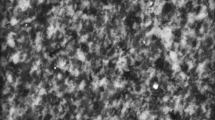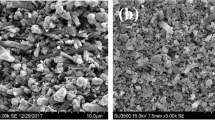Abstract
A study was undertaken to investigate the wear characteristics of polycrystalline cubic boron nitride (PCBN) cutting tools and surface integrity during machining of STAVAX (specialised stainless steel) with and without coolant. Plastic deformation and formation of overtempered martensite and white layer (untempered martensite) were the dominant subsurface and surface defects. It was found that decreasing the hardness of the STAVAX from 55 HRC to 40 HRC could result in fracture on the flank face, leading to a deterioration of the surface finish. It was observed that low CBN content tools (60%CBN/40%TiN) exhibited greater fracture resistance than high CBN content tools (85%CBN/15%TiN, 90%CBN/10%Co). Although coolant could not bring about a reduction in the flank wear, it was effective in reducing the subsurface and surface defects, and in preventing chipping of the tool edge, leading to an improved surface finish. A superior surface finish (Ra<0.3 μm) was obtained with cutting fluid using a tool with a radius of 0.8 mm, depth of cut of 0.05 mm and feed rate of 0.05 mm/rev.
















Similar content being viewed by others
References
Kishawy HA, Elbestawi MA (2001) Tool wear and surface integrity during high-speed turning of hardened steel with polycrystalline cubic boron nitride tools. In: Proceedings of Institute Mechanical Engineers 215(Part B):755–767
Bhattacharyya SK, Aspinwall D (1998) The application of polycrystalline tooling. Machining Hard Materials, pp 95–103
Zimmermann M, Lahres M, Viens DV, Laube BL (1997) Investigations of the wear of cubic boron nitride cutting tools using auger electron spectroscopy and X-ray analysis by EPMA. Wear 209:241–246
Luo SY, Liao YS, Tsai TY (1999) Wear characteristics in turning high hardness alloy steel by ceramic and CBN tools. J Mater Proc Technol 88:114–121
Köing W, Neises A (1993) Wear mechanisms of ultrahard, non-metallic cutting materials. Wear 162–164:12–21
Shintani K, Ueki M, Fujimura Y (1989) Optimum tool geometry of CBN tool for continuous turning of carburized steel. Int J Mach 29(3):403–413
Chou YK, Evans CJ (1997) Tool wear mechanism in continuous cutting of hardened tool steel. Wear 212:59–65
Chou YK, Evans CJ (2002) Experimental investigation on CBN turning of hardened AISI 52100 steel. J Mater Proc Technol 124:274–283
Barry J, Byrne G (2001) Cutting tool wear in the machining of hardened steels. Part II: cubic boron nitride cutting tool wear. Wear 247:152–160
Klimenko SA, Mukovoz YA, Lyashko VA, Vashchenko AN, Ogorodnik VV (1992) On the wear mechanism of cubic boron nitride base cutting tools. Wear 157:1–7
Jawaid A, Olajire KA, Ezugwu EO (2001) Machining of martensitic stainless steel (JETHETE) with coated carbides. In: Proceedings Institute Mechanical Engineers 215(Part B):769–779
Lo Casto S, Lo Valvo E, Lucchini E, Maschio S, Piacentini M, Ruisi VF (1999) Ceramic materials wear mechanisms when cutting nickel-based alloys. Wear 225–229:227–233
Ezugwu EO, Olajire KA (2002) Evaluation of machining performance of martensitic stainless steel (JETHETE). Tribol Lett 12:183–187
Liu CR, Mittal S (1998) Optimal pre-stressing the surface of a component by superfinish hard turning for maximum fatigue life in rolling contact. Wear 219:128–140
Matsumoto Y, Hashimoto F, Lahoti G (1999) Surface integrity generated by precision hard turning. Ann CIRP 48:59–62
Mamalis AG, Kundrak J, Gyani K (2002) On the dry machining of steel surfaces using superhard tools. Int J Adv Manuf Technol 19:157–162
Bailey JA, Jeelani S, Becker SE (1976) Surface integrity in machining AISI 4340 steel. J Eng Ind, T ASME 98:999–1007
Tönshoff HK, Wobker HG, Brandt D (1995) Tribological aspects of hard turning with ceramic tools. J Soc Tribol Lubric Eng 51:163–168
Liu CR, Barash MM (1982) Variables governing patterns of mechanical residual stress in a machined surface. T ASME, J Eng Ind 104:257–264
Ding X, Liew WYH, Ngoi BKA, Gan JGK, Yeo SH (2002) Wear of CBN tools in ultra-precision machining of STAVAX. Tribol Lett 12:3–12
Liew WYH, Ngoi BKA, Lu YG (2003) Wear characteristics of PCBN tools in the ultra-precision machining of STAVAX at low speeds. Wear 254:267–277
Yeo SH, Ong SH (2000) Assessment of the thermal affects on chip surfaces. J Mat Proc Technol 98:317–321
Nakai T, Goto M (1995) Hard sintered compact for tools. U.S. Patent 5,395,700
Chou YK, Evans CJ (1999) Cubic boron nitride tool wear in interrupted hard cutting. Wear 225–229:234–245
Wang ZY, Rajurkar KP (1997) Wear of CBN tool in turning of silicon nitride with cryogenic cooling. Int J Mach 37:319–326
Trent EM, Wright PK (2000) Metal Cutting, Butterworth-Heinemann
Poulachon G, Moisan A, Jawahir IS (2001) Tool-wear mechanisms in hard turning with polycrystalline cubic boron nitride tools. Wear 250:576–586
Acknowledgements
This work was supported in part by the funding for Precision Engineering and Nanotechnology Centre from Agency for Science, Technology and Research, Singapore. The authors would like to acknowledge the technical support by Mr. W.L. Koh in carrying out the experimental work.
Author information
Authors and Affiliations
Corresponding author
Rights and permissions
About this article
Cite this article
Liew, W.Y.H., Yuan, S. & Ngoi, B.K.A. Evaluation of machining performance of STAVAX with PCBN tools. Int J Adv Manuf Technol 23, 11–19 (2004). https://doi.org/10.1007/s00170-002-1520-y
Received:
Accepted:
Published:
Issue Date:
DOI: https://doi.org/10.1007/s00170-002-1520-y




